► M2 vs Type R vs 718 GTS
► The petrol performance car lives
► Three of the best battle it out
If the petrol performance car’s days are numbered, here are three to be treasured forever. BMW’s new M2 meets the Porsche Cayman GTS and Honda’s latest Civic Type R.
Pre-flight briefing: BMW M2
Why is it here?
Because it’s one of the most hotly anticipated new cars of the year. The latest M3/M4 is proving to be a bit of a superstar, and the M2 stretches the 2-series monocoque before hot-rodding it with a bunch of M3/M4 parts, including 10-stage traction control and a version of the same engine – and on the M2 you’ve the option of a manual gearbox.
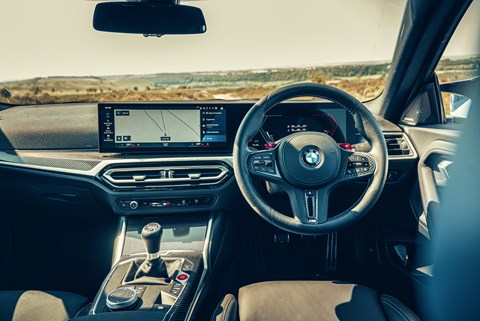
Any clever stuff?
Lots, not least BMW’s dazzling OS8 infotainment, with its widescreen/twin-screen cockpit and extensive drive mode configuration possibilities. Oily clever stuff includes the punchy and characterful S58 six and M’s active differential.
Which version is this?
There’s only one M2, but the options list is extensive. We’ve the Comfort pack (heated steering wheel, comfort access and phone storage with wireless charging for £730), bi-colour wheels (£330), Driving Assistant (£1100), Adaptive Cruise and the M Driver’s pack (deletes the 155mph limiter for £2305). The scarily priced £9k M Race Track pack brings the derestricted top speed and some carbon interior trim, but the big two are the love-’em-or-hate-’em M carbonfibre bucket seats and the carbon roof, lowering weight and of course the centre of gravity.
Pre-flight briefing: Honda Civic Type R
Why is it here?
Because if you’re after a deadly serious performance car for £50k, the greatest Civic Type R to date – and one of the best fast cars Honda’s ever created – deserves your consideration.
Any clever stuff?
For this Type R, Honda effectively took the engineering of the previous car, fettled and honed the oily bits, and lovingly dovetailed it with a much-modified current-gen Civic bodyshell. Wheelbase is up 35mm over the previous Type R, track is wider and the car lower. Camber stiffness is up 16 per cent, the car retains its almost torque-steer-immune dual-axis front suspension, and stiffer tie-rod ends and honed bearings work with a 60 per cent more rigid steering torsion bar to bring about a pretty telepathic connection with the front wheels.
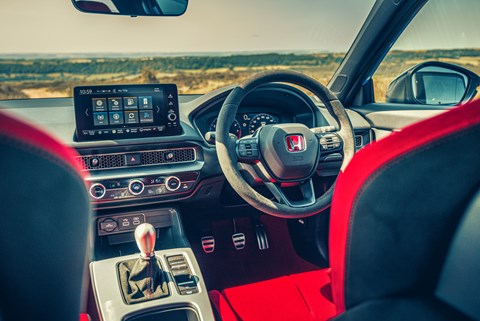
The shell’s 38 per cent stiffer in torsion, thanks mostly to the use of more adhesive, the aluminium bonnet’s nearly half the weight of the old car’s and the tailgate 20 per cent lighter. Up front, the engine and gearbox too have been tickled – a lighter flywheel here, a few deleted turbine blades there.
Which version is this?
There’s only one. Just choose your colour.
Pre-flight briefing: Porsche 718 Cayman GTS 4.0
Why is it here?
If you’re talking fast, rewarding cars costing the right side of £100,000, the 718 Cayman has to be in the conversation (not least because it’s quite difficult to buy a 911 these days without straying into six figures).
Any clever stuff?
It’s all clever, just not particularly digital. The 718’s infotainment is a full generation behind that of the 911 (logical, given the two-seater is in its twilight years) but it’s CarPlay compatible and works fine.
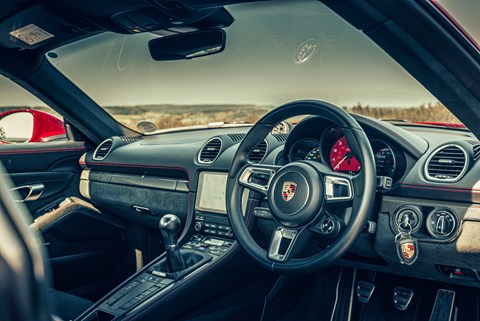
Which version is this?
The 718 Cayman range comprises four cars (the £52k base car, the £62k S, the £73k GTS and the £82k GT4) but really it’s a range of two halves: the more affordable cars, with their four-cylinder turbo; and the six-cylinder GTS and track-ready GT4. This is the less expensive, more road-focused of the two sixes and the sweet spot of the range (probably). Options swell this car’s list price by nearly £10k (the £2k GTS interior package and £1400 LED headlight package are key contributors; both are more nice-to-have than must-have) but you don’t need much of it – the GTS’s bespoke, lower suspension set-up is standard-issue, as are the brakes and no-cost manual gearbox option.
M2 vs Type R vs Cayman GTS 4.0: the test

Stadium-filling stargazer Professor Brian Cox loves nothing more than to latch on to some apparently straightforward idea and, dragging it with him, dive headfirst down a wormhole to the abstract. Throw in surrealist comedians James Acaster and Ed Gamble, of the Off Menu podcast, and you’re set for a supermassive saunter into the brain-stretchingly weird.
As the BMW M2 powers south, heading cross-country on a back-roads last hurrah (and overtaking everything in its path with impressive impunity) before hooking up with the A1 (where it will prove far quieter than the Porsche 718 Cayman GTS I drove up in, if a touch less fuel efficient), Gamble and Acaster are imploring Cox to use his influence to end the search for dark matter. The clue, they point out, is in the name. The stuff is evidently evil. And clearly it does not wish to be found. So leave it be.
Cox is having none of it. Dark matter, like sand, cannot wish for anything. Its elusiveness is not deliberate because dark matter lacks consciousness. It therefore also lacks the means to be evil.
Then, in that Coxian way, he warms to the idea. Perhaps sand – the less abstract substitute for dark matter in this instance – might be formed into a ‘thought engine’ with a semblance of consciousness. Then it could wish to remain undiscovered. And it could be evil.
And if we can conceive of a pile of sand having a personality then a collection of interlinked mechanical and electronic systems definitely can. The new BMW M2 is, by M’s own admission, a modified 2-series monocoque stuffed with a bunch of M3/M4 parts and systems. Of course, this is not a new page in the M playbook – the previous M2 used a similar recipe, as did the lauded and influential 1M Coupe.
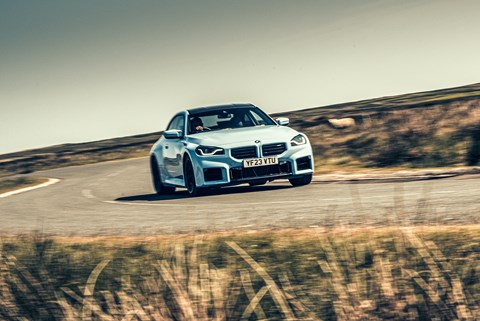
To be clear, adopting a bunch of M3/M4 components a fine idea. In their various guises these cars have been busy winning nearly as many CAR Giant Tests as the Tesla Model 3. But for the latest M2 to begin to carve out its place in the world, not to mention the right to stand among the greats, requires that its pile of sand be imbued with a personality all its own. Because on paper the new M2 looks an awful lot like an M4 lite.
It is 1887mm wide, weighs 1775kg with the six-speed manual gearbox (1800kg with the auto) and runs 0-62mph in 4.3 seconds (4.1 seconds for the auto). The 503bhp M4 is the same width, the same weight (there is no manual M4 in the UK), sits on the same Michelin Pilot Sport 4S tyres and runs 0-62mph in 3.9sec thanks to the same engine in a higher state of tune. Similar sand.
The M2 passes its first test within 10 miles of me climbing behind the fat-rimmed wheel, adjusting the seat (and wishing it would drop an inch lower) and trying – and failing – to start the car. ‘Depress clutch to start.’ Ah. New cars with manual gearboxes really are white-rhino rare in 2023.
Last year I was fortunate enough to spend six months with an M4 Competition. For whatever reason I adored it without ever digging into the tail-out nonsense you might consider meat and drink for a rear-drive BMW coupe with a powerful straight-six snug against the front bulkhead. Nor did I ever feel inclined to wind off the electronics that so effectively flattered my incompetence, preferring instead to revel in the car’s incredible traction and front-axle grip, both of which towered over the same traits in the previous-generation car. Perhaps it was the numbers; £85k and a shade over 500bhp. But are this M2’s 454bhp and £69,355 (as tested) really so different?
I’ve set up the individually configurable ‘M2’ setting as DSC off, with the variable traction control at bang-in-the-middle 5, and Sport steering, engine and brakes. Yep, there are two brake settings; one that works nicely when you’re flying and a less grabby alternative for when you’re not. Moments later I’m merrily smearing the BMW into the best bits of one of my favourite routes, gorging on its well-sighted and positively-cambered goodness like a castaway with a freshly roasted boar.
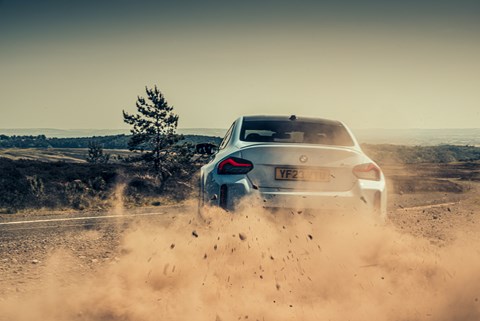
Great things being to happen. A decent lick of entry speed is easy because that front end is so pinned; so reassuringly understeer-immune. From there you need only summon something like the right gear, so that the tall-geared six (the M2 will bust the motorway speed limit in second and roam north of 100mph in third, I’m told) is awake, and you can set about toying with the car’s fantastic balance as you want. Put some energy into the car with the throttle and the way in ⊲ which you can intuitively rotate it through turns is both rewarding and straightforward, the rears happily heading into that malleable grip/slip grey area with a linearity that breeds enormous confidence. The quick steering helps too. With that multi-stage traction control on hand to catch you should you fall, the M2 sets you free to enjoy yourself. Where the M3 and M4 major on awesome ability, the M2’s pile of sand has an addictive playfulness; a distinctly looser and more fun-loving character engineered in via carefully crafted code and considered calibration.
This, in a way, is BMW as it’s always been – certainly as it’s been when it’s been on form. Think 1800Ti (yep, a blast, even with its recirculating-ball steering…), 2002 Turbo, E30 M3. Is their exploitable balance not a product of their timeless front-engined, rear-drive layout, a configuration more conducive to this most indulgent style of driving than any other?
Perhaps, and certainly front-drive hot hatches and mid-engined sports cars can be more coded in the way they move; dynamic Rubik’s cubes that reward a little perseverance. But, in the strange days of 2023, it is among front-drive hot hatches and mid-engined sports cars that the M2 finds itself. As a front-engined, rear-wheel-drive coupe it has no obvious rivals (except perhaps Ford’s Mustang, a very different creature). But as a £70,000-ish high-performance plaything it’s up against the both the evergreen 718 Cayman and one of the greatest cars Honda has ever built, the sixth-generation FL5 Civic Type R.
Surreally, the Yorkshire Moors have swapped their typical rain-sodden gloom for a ferocious combination of blinding light and sledgehammer heat. Together they’ve transformed this bleak wilderness into a dust-blown approximation of the Californian desert. A hairdryer-hot breeze races across this place of sheep and gorse and terrifyingly fast corners, rattling at the branches of the pine I’m vainly sheltering beneath like a toddler pulling at a puppy’s ears.
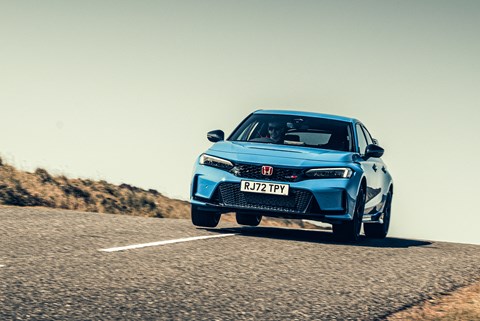
I jump into the Civic and tug shut the door with a cheap clang. I last drove the Type R out on the launch and it’s good to be back, the Civic’s ordinary underpinnings elevated by plush-feeling materials in trademark red on all the key touchpoints, the car’s gorgeously comfy bucket seats and that alloy gearlever.
More rigid of body, longer in the wheelbase and considerably more expensive than the superb FK8 Type R it replaced, nothing better exemplifies the FL5’s dedication to marginal gains like its drive-modes menu. Previously you couldn’t mix compliant damping with, say, the sportier powertrain settings. Now you can. So I do, then start the engine, grab first and race up the road at the head of a slo-mo comet’s tail of dust.
Holy cow. Moments earlier, the M2 was quick but a little edgy on these fast and bumpy moorland roads. The BMW’s damping is sweetly judged, dealing with lumps and bumps in a single assured stroke, but the steering feels a little light and rubbery and remote, and that chassis looseness – so fun on smooth roundabouts at 50mph – is less welcome as speeds rise and the surface goes to hell. By contrast the Honda is imperious, its outrageous combination of speed and composure across these wide-open spaces literally breathtaking. As in, I keep forgetting to breathe.
You sit low (again, lower would be better) and snug in the big Honda (it feels particularly massive after the Porsche), grateful for the normal steering wheel (nicer in your hands than the BMW’s fat-rimmed monster, and wrapped in alcantara like the GTS’s more potent sibling, the Cayman GT4) and its deliciously consistent and accurate action. And so, happy and free in the spaces between dawdling Suzuki SX4s, you just fly, apparently beyond the reach of earthly concerns like instability, physics or leaving the road.
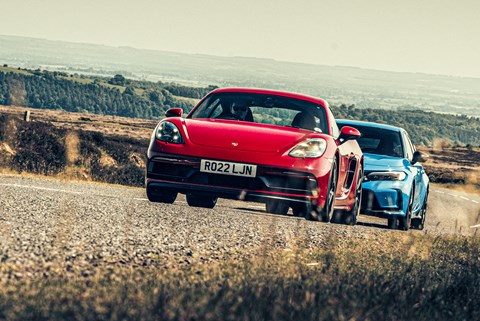
Obviously, the engine is the least impressive of the three. In less incredible driving environments than this the Type R never feels anything less than ballistic. But the widescreen scale of this place, not to mention a 454bhp BMW and a 395bhp Porsche for company, soon puts the Honda in its place. Though in truth it’s the complete lack of character that hurts more. The 2.0-litre four is a means to an end, nothing more. Predictably dull and unresponsive low down (the BMW, too, is snoozy below 3000rpm), it’s alive from 4000rpm, ripples the front axle with the merest hint of torque steer at 5000rpm and kicks with a broad and usable top end that works well on a racetrack. And, er, here.
But the Honda’s gearbox is better than the BMW’s (sweeter action and the lever’s closer to the wheel, making the BMW’s feel like it’s high and somehow behind you), as are the steering (more feel, more natural) and the brakes (firm pedal, gorgeously progressive action). The chassis also runs the Porsche close on all the good stuff; composure, communication, grip and control, certainly at sane road speeds.
As more than one CAR road tester has said previously, despite hailing from the other side of the world and being of a body style Porsche has never built, the Civic Type R feels like a Porsche in many ways. It’s as if a Stuttgart special ops team went rogue, bought a Civic and spent their evenings mutating a hatchback with the same philosophies and engineering practices that make cars like the Cayman GTS so special.
Back on the road, hot coarse tarmac blurring beneath the Civic’s gummy Michelins (it too wears Pilot Sports), the flow this approachable, talented and ludicrously confidence-inspiring car is conjuring is quite spellbinding. I’ve given up really slowing for corners, so massive are the Honda’s grip and composure, brushing the brakes instead only to settle the nose before sending it arcing into another fast, fourth-gear test of how effectively I can hang on to my breakfast.
The Type R’s front-engined and front-wheel drive, of course, so you might reasonably expect understeer under duress, a speed-sapping tendency to flop onto its outside front wheel on turn-in and plenty of unseemly scrabbling when the turbo’s puffing hard. But no. Instead the Honda moves with the oiled composure of a decadently appointed and perfectly set-up competition car. It shrugs off hits to the suspension, changes direction smartly but without so much as a waggle of rear-end nervousness, responds predictably to tweaks of throttle and sheds speed like a carbon-disc’d F1 car when a lamb wanders out of the heather, presumably for a closer inspection of the factory-looking Brembo calipers. Only as the Michelins finally begin to howl and the road sends a bunch of ill-timed ripples the Honda’s way does its composure slip, the car sometimes hopping as the forces involved fight it out.
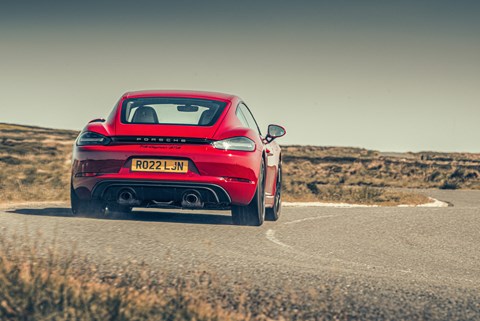
I make sure all our testers drive the M2 before they drive the Cayman, the better to leave their response to the brawny Bavarian uncorrupted. But drive the GTS they inevitably must, and one by one they all experience the same thing: a humbling reminder of the Porsche’s class.
We’re forever being accused of a sickly excess of Porsche love. The truth, uncomfortable as it might be, is that the GTS nails almost everything that matters – as well it might given the head starts conferred by its two-seat, mid-engined layout and turbo-free engine.
Where the M2 is a weighty car made to feel lighter by a torque-rich turbo engine and some overly assisted controls at times, the Cayman dances to a more honest, back-to-basics tune. At 1405kg it’s three people lighter than the BMW, as is the 1429kg Honda. The GTS’s power-to-weight ratio, at 281bhp per tonne, is usefully punchier than the BMW’s (256bhp per tonne), helping explain both why the M2 never feels as accelerative as the numbers suggest it should and why, given any real revs on the likeably analogue instruments, the GTS 4.0 feels bombastically rapid. So much engine crammed into such a small car is a goosebump-inducing combination – and then there’s the noise and the throttle response, both of which are sublime and vanishingly rare.
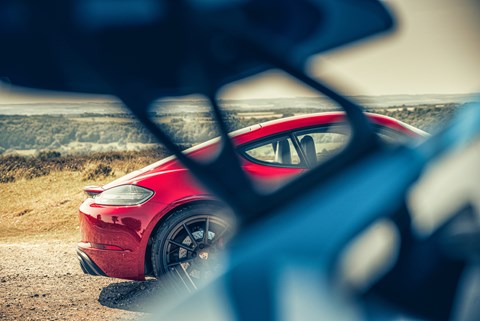
Screen smeared in bugs, its black wheels grey with brake dust, the Cayman is red hot as I climb in. Your sight lines, that sense of being plugged into the car, the ergonomics… everything is just as you’d want it. Half a dozen gearchanges in you realise that, while the BMW’s shift (with only 1000 miles of running-in, granted) is good, and a nice extension of its heavyweight, almost muscle-car vibe, the Porsche’s is far cleaner, more accurate (missed shifts are non-existent), more satisfying and more sweetly in tune with the clutch action.
And while the BMW’s engine sounds pretty good, its six-cylinder high notes underscored by the dull thud of discharged pressure, the high-rpm boxer soundtrack is enough to justify the car’s asking price almost single-handedly.
After knocking you back onto the ropes with its first class powertrain, the Cayman pops you down on the canvas with a chassis so fluid, so capable and so damn sorted that it leaves you more than a little discombobulated.
What, you’re left thinking, do you have to do to break its composure? Where are its limits? Does it have limits? And why have you spent years searching for a driving experience this meltwater-pure in cars that weren’t themselves pure-bred sports cars by design?
Final reckoning: brace yourself, Porsche wins
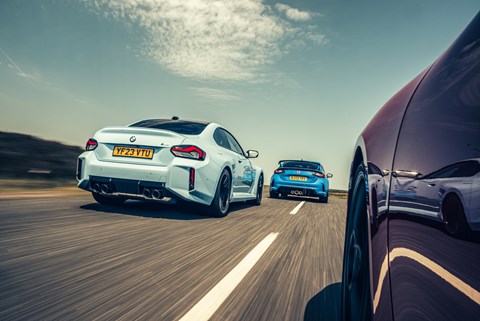
It’s hardly the Cayman’s fault it has no rear seats, just as it’s hardly the M2’s fault it’s not a pure-bred sports car. M1 supercar aside, that just isn’t the M way. But the 718 Cayman GTS 4.0 is a timely reminder of just how much greatness £75k can buy.
Adore the M2 though we do, you can’t decide the Porsche has the best steering, the best chassis, the best gearbox and the best engine and then not hand it the win. Should the Cayman in the test have been the S, the 2.5-litre turbo four priced at £62k, which is the Cayman you can actually buy for M2 money? Perhaps, and certainly Porsche’s drastic price hikes earlier this year have made GTS versus M2 look a little unfair.
Undoubtedly it’d be a closer-run thing with the S. But many buying a Cayman find the extra needed to get a GTS, and choosing the S would only have removed one of the Porsche’s strengths, its engine.
Put the BMW and Honda into the ring together and they look set to trade blows for 10 rounds. The BMW has the far more powerful and more emotionally engaging engine, feels roughly £50k more expensive inside, has infotainment that makes the perfectly functional Honda set-up feel 8-bit and, with its rear-drive layout, is your ticket to a fun world of smoky launches and throttle-based cornering fun. The Civic bests the BMW on brake feel, steering and gearbox. And while the BMW is a decent chunk of change less expensive than the Porsche, the Honda – priced from £49,090, if you can get your hands on one (Honda UK isn’t running a waiting list, so start wining and dining your dealer ahead of the next allocation) – is more affordable than the M2 by an even greater margin.
Of the two, I’d flirt pretty seriously with the idea of the Honda, then buy an M2. That much power through that axle is just too exciting a combination to resist and, while the Honda shows its pretty magnificent hand straight away, the BMW feels like it will offer more longevity, keeping you driving and learning and getting more from it as the two of you bond. And in the autumn of the petrol-engined performance car, a front-row seat in the M2’s buckets feels like a more appropriately decadent place in which to try to outrun the dying of the light.
M2 vs Type R vs Cayman GTS: verdict
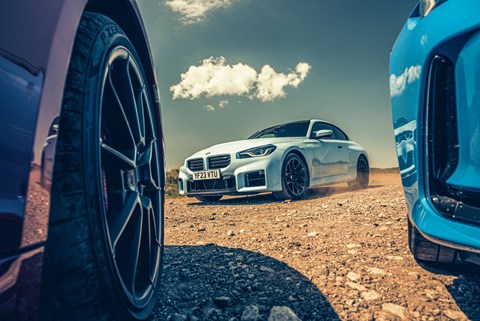
First place
Porsche 718 Cayman GTS
The best all-round version of the best mid-engined sports car on sale
Second place
BMW M2
Flawed but flamboyant, and big on old-school appeal. A fitting M2 swansong
Third place
Honda Civic Type R
An outrageously good hot hatch that runs the M2 in particular close. An all-time great